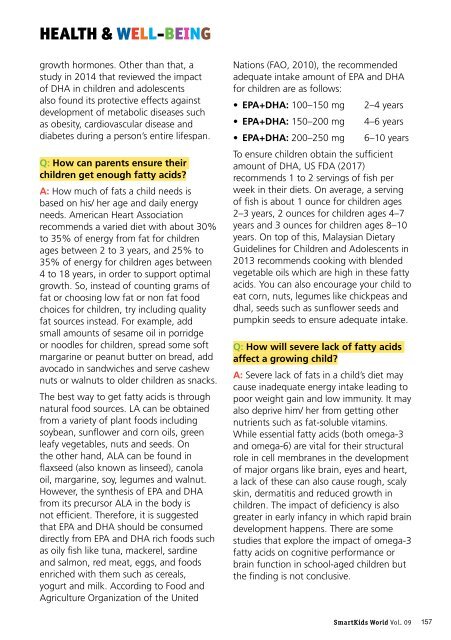SKW ENG V09
Create successful ePaper yourself
Turn your PDF publications into a flip-book with our unique Google optimized e-Paper software.
HEALTH & WELL-BEING<br />
growth hormones. Other than that, a<br />
study in 2014 that reviewed the impact<br />
of DHA in children and adolescents<br />
also found its protective effects against<br />
development of metabolic diseases such<br />
as obesity, cardiovascular disease and<br />
diabetes during a person’s entire lifespan.<br />
Q: How can parents ensure their<br />
children get enough fatty acids?<br />
A: How much of fats a child needs is<br />
based on his/ her age and daily energy<br />
needs. American Heart Association<br />
recommends a varied diet with about 30%<br />
to 35% of energy from fat for children<br />
ages between 2 to 3 years, and 25% to<br />
35% of energy for children ages between<br />
4 to 18 years, in order to support optimal<br />
growth. So, instead of counting grams of<br />
fat or choosing low fat or non fat food<br />
choices for children, try including quality<br />
fat sources instead. For example, add<br />
small amounts of sesame oil in porridge<br />
or noodles for children, spread some soft<br />
margarine or peanut butter on bread, add<br />
avocado in sandwiches and serve cashew<br />
nuts or walnuts to older children as snacks.<br />
The best way to get fatty acids is through<br />
natural food sources. LA can be obtained<br />
from a variety of plant foods including<br />
soybean, sunflower and corn oils, green<br />
leafy vegetables, nuts and seeds. On<br />
the other hand, ALA can be found in<br />
flaxseed (also known as linseed), canola<br />
oil, margarine, soy, legumes and walnut.<br />
However, the synthesis of EPA and DHA<br />
from its precursor ALA in the body is<br />
not efficient. Therefore, it is suggested<br />
that EPA and DHA should be consumed<br />
directly from EPA and DHA rich foods such<br />
as oily fish like tuna, mackerel, sardine<br />
and salmon, red meat, eggs, and foods<br />
enriched with them such as cereals,<br />
yogurt and milk. According to Food and<br />
Agriculture Organization of the United<br />
Nations (FAO, 2010), the recommended<br />
adequate intake amount of EPA and DHA<br />
for children are as follows:<br />
• EPA+DHA: 100–150 mg 2–4 years<br />
• EPA+DHA: 150–200 mg 4–6 years<br />
• EPA+DHA: 200–250 mg 6–10 years<br />
To ensure children obtain the sufficient<br />
amount of DHA, US FDA (2017)<br />
recommends 1 to 2 servings of fish per<br />
week in their diets. On average, a serving<br />
of fish is about 1 ounce for children ages<br />
2–3 years, 2 ounces for children ages 4–7<br />
years and 3 ounces for children ages 8–10<br />
years. On top of this, Malaysian Dietary<br />
Guidelines for Children and Adolescents in<br />
2013 recommends cooking with blended<br />
vegetable oils which are high in these fatty<br />
acids. You can also encourage your child to<br />
eat corn, nuts, legumes like chickpeas and<br />
dhal, seeds such as sunflower seeds and<br />
pumpkin seeds to ensure adequate intake.<br />
Q: How will severe lack of fatty acids<br />
affect a growing child?<br />
A: Severe lack of fats in a child’s diet may<br />
cause inadequate energy intake leading to<br />
poor weight gain and low immunity. It may<br />
also deprive him/ her from getting other<br />
nutrients such as fat-soluble vitamins.<br />
While essential fatty acids (both omega-3<br />
and omega-6) are vital for their structural<br />
role in cell membranes in the development<br />
of major organs like brain, eyes and heart,<br />
a lack of these can also cause rough, scaly<br />
skin, dermatitis and reduced growth in<br />
children. The impact of deficiency is also<br />
greater in early infancy in which rapid brain<br />
development happens. There are some<br />
studies that explore the impact of omega-3<br />
fatty acids on cognitive performance or<br />
brain function in school-aged children but<br />
the finding is not conclusive.<br />
SmartKids World Vol. 09 157

















